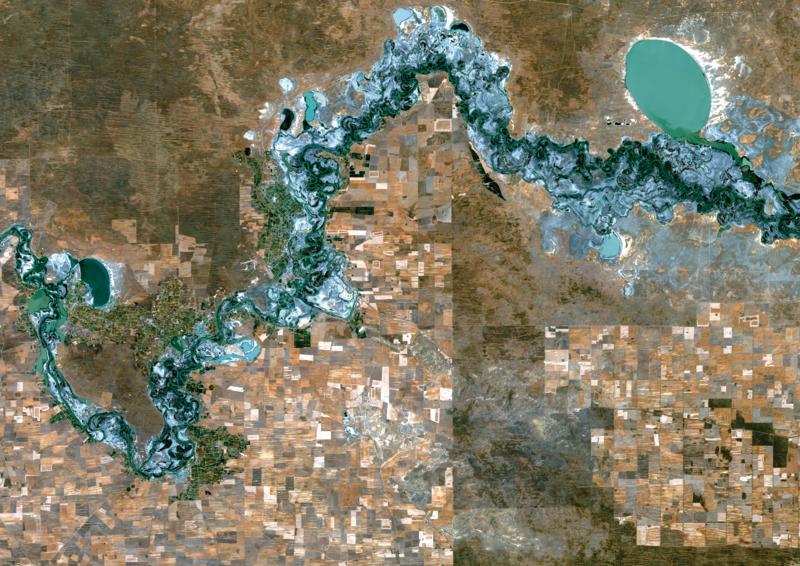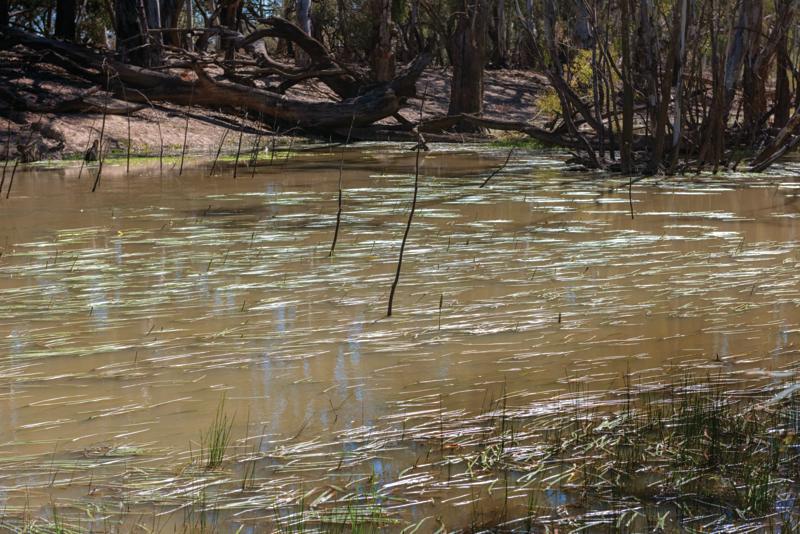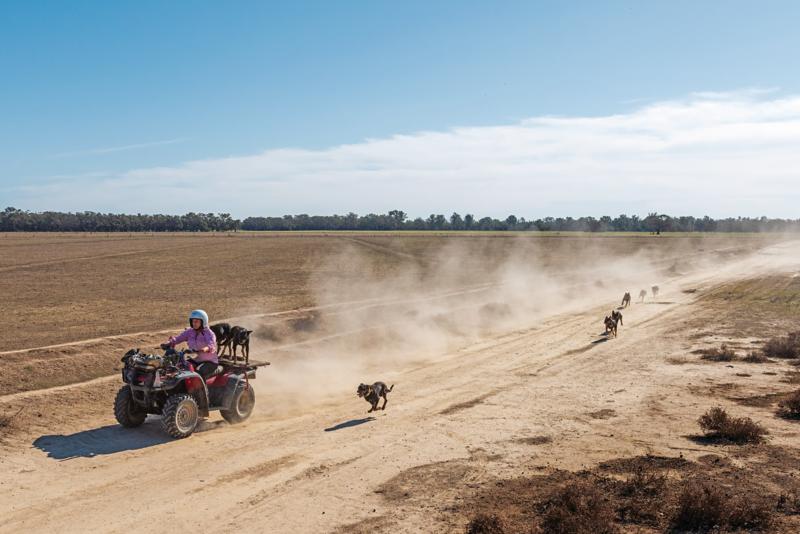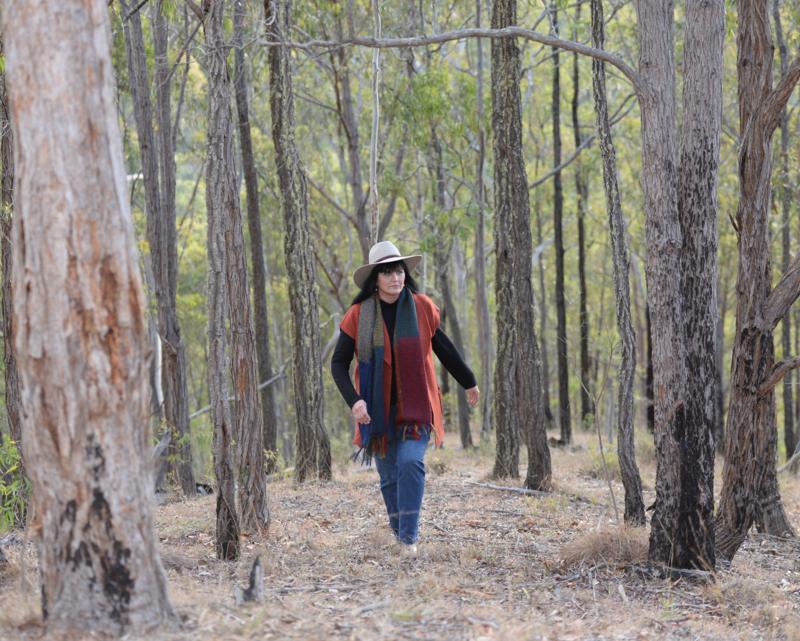IT'S bizarre. In an area where farmers are forced onto a zero water allocation, they can also be faced with devastating floods.
Deniliquin-district farmer Louise Burge knows this only too well. Back in 2010, she says the release of environmental flows during harvest led to a high river event that prevented access to an isolated part of her family’s property where crops were ready for harvest. Delayed harvest and subsequent rain meant they lost the lot.
In a catastrophic flood in 2016, the family had to swim thousands of sheep to safety off land she says was inundated due to mismanagement of the Hume Dam and Murray River. The flood damage to land and feed production from that flood is now exacerbated by drought and zero water allocation.
“Our region wears the majority of water recovery under the Murray-Darling Basin Plan and so has increased flooding risks to riparian property owners from Albury right through to Wakool,” Louise says. “And at the same time, we don’t get decent annual water allocations.” The zero water allocation for large numbers of irrigators across the southern Murray-Darling Basin is causing concern for many farmers – probably because this is the first big drought since the Plan began six years ago.
Farmers who installed centre-pivot irrigators to deliver irrigation efficiencies with the goal of freeing up water for the environment have been left with no water to run them. As a result their crops have shrivelled.
ALSO READ: Murray-Darling Basin water report confirms little improvement
 The Murray River is Australia’s longest river. Source: Getty Images.
'Farmers made the fall guy in water-sharing arrangements'
The Murray River is Australia’s longest river. Source: Getty Images.
'Farmers made the fall guy in water-sharing arrangements'
Southern Riverina Irrigators chair Chris Brooks from Barooga, NSW, says there are canola crops planted under pivots this season that aren’t even worth windrowing – and this is symptomatic of what is happening across the district and the 1,800 farms he represents in his lobbying role.
Chris says there was plenty of water in the dams at the start of the irrigation season, with 90% in Dartmouth Dam and 50% in Hume Dam, the two major catchments supplying irrigators along the Murray River. “If we get zero allocation when the dam levels are this high, will we only get 10% water allocation if the dams are full?” he wonders.
“As farmers, we are not greedy, angry or stupid. We understand that when there is no water in the dam we don’t get an irrigation allocation.
“But when we start the season with 90% in Dartmouth and a 0% allocation for irrigators, it shows we have been made the fall guy for the Murray-Darling Basin Plan and in water-sharing arrangements.” Chris says irrigators feel they are footing the water bill for promises made under a raft of changes to river and Basin management – and for some it means walking away from farming.

The Bullatale Creek, which runs through Louise Burge’s property, is a tributary of the Murray River.
Tough times with zero water allocations
The Murray-Darling Basin Plan came into effect in 2012 yet this is the first year irrigators have seen a zero allocation in the NSW Murray system. Murray-Darling Basin Authority (MDBA) executive director of partnerships Carl Binning says the Basin Plan is “more important than ever in times of drought”.
In October, he told the International River Symposium in Sydney the Basin Plan provides a global example of how cooperation in managing rivers and waters across multiple jurisdictions can be achieved while balancing multiple interests. “Water is allocated to individual users and the environment based on shares of the amount of water available each year,” he said. “Water trade then allows water to be used when it is most needed.”
The Basin Plan, which covers four states and one territory, “shares available water fairly between communities, farmers and the environment”, according to Carl. On the ground, however, it’s not always seen the same way.
Louise Burge has closely monitored water reforms including the Basin Plan, and is concerned that of the 2,750 gigalitre (GL) Basin Plan recovery target, 2,289GL is being recovered from the southern Basin, primarily in the NSW Murray and the Goulburn Valley in Victoria. Now, she says, there’s a push for a further 450GL. “The Plan is not balanced,” she says.
She has seen firsthand the impacts the Basin Plan and zero allocation has on the family business she runs with her husband Andrew west of Deniliquin. Their main sheep and cropping property is boosted by small areas under surface water irrigation, which have been a saviour, as irrigation has allowed them to produce feed each autumn to maintain their flock.
“With a zero water allocation, that’s going to be extremely difficult,” she says. “We only have a small amount of carryover [unused water allocated to licence holders in previous years], zero allocation this year and we are expecting another zero allocation in 2019, unless there is a super-wet year. We do fortunately have some groundwater but water entitlements have also been cut significantly in the past, so it’s now about how to juggle a myriad decisions, finding cash flow with some small cropping opportunities and growing feed for stock.”
RELATED ARTICLE: Tamworth farmer diversifies from beef to hay
 The zero water allocation is making life tough for Louise and her 8 working dogs.
The zero water allocation is making life tough for Louise and her 8 working dogs.
She says zero surface water allocation has simply compounded years of clawbacks of precious water resources, which she says have hit Murray Valley irrigators harder than many other regions. Deniliquin and other communities in the region are already hurting.
“There are immediate implications on businesses and communities right now in terms of having 0% allocation,” Louise says. “It’s affected the water market, there have been job losses and there has been a flow-on effect to other industries like dairy and rice that operate along the Murray River system.”
Adding to the woes of existing irrigators are mass corporate plantings of almond trees downstream near the South Australian/Victorian border. Louise says many were planted without permanent water supplies, so there is increased competition to buy temporary water. “The current water use of those young trees is about three-to-four megalitres a hectare, but when they are mature, water usage will rise rapidly to about 17-to-18 megalitres a hectare,” she says. “There are thousands and thousands of immature trees and also thousands of hectares still to be planted. This demand for temporary water, combined with the Basin Plan impacts, makes the non-corporate sector seem like it has a very risky future.”
Related Murray-Darling Basin articles
MDBA river management executive director Andrew Reynolds says that under the Murray-Darling Basin Agreement, NSW and Victoria are required to meet South Australia’s water entitlement in equal shares and flow is delivered accordingly. With Menindee Lakes on the Darling River in Western NSW at extremely low levels, they are not contributing to the state’s share of the flow to South Australia.
As a result, Andrew says, the majority of the NSW contribution is being met from the state’s share of the Murray River storages. But Louise believes this won’t be an isolated incident and remains concerned that low flows from the Darling will continue to impact on Murray allocations.
“It seems the Murray River system is carrying the can for everyone else in terms of contributing water to the Murray-Darling Basin Plan goals,” she says. “The zero allocation this year is one thing, but we are looking at the Murray contributing more than its share to appease political decisions. “The decisions have pitted farmer against farmer in local areas, it’s decimating communities and running down equity in farms due to low water reliability. The zero allocation is just the tip of the iceberg.”
“The decisions have pitted farmer against farmer, it’s decimating communities and running down equity in farms due to low water reliability.”
Is NSW carrying the water burden of other states?
NSW Farmers’ Conservation & Resource Management Committee chair Bronwyn Petrie says it appears NSW seems to be bearing the brunt of decisions made to bolster supplies of water to South Australia. She says it must be galling for irrigators along the Murray River system to see a full river through spring and have no irrigation allocation at all.
RELATED ARTICLE: Native vegetation mapping controversy
Earlier in the irrigation season, Bronwyn was part of a push by NSW Farmers to try to get at least 1% allocation, to allow farmers to finish crops they had already planted. The proposal was to allow water to be borrowed against future allocations. This made sense, she says, given those crops had the potential to supply a fodder and grain-hungry market across eastern Australia, and it would have been a clear way for the government to provide drought assistance. The NSW government didn’t agree. Instead it offered 15GL of environmental water for sale, water Bronwyn says could have been allocated to farmers in catchments that had no allocation.
 Bronwyn Petrie is fighting with NSW farmers to try and get at least 1% water allocation. Source: Fairfax Media.
She is also puzzled why in such a dry year, forests in Victoria are receiving environmental flows, when naturally in a drought year they would receive no water at all. According to the MDBA’s Basin environmental watering outlook for 2018-19, the reason for this is “water managers are consolidating positive environmental outcomes from previous years and delivering water to build system-scale resilience”.
Given the amount of water that was in the dams but unavailable to water users, Bronwyn says NSW Farmers is calling for a public register giving a breakdown of allocations of the water held in dams, including deliveries to South Australia, permanent horticulture and carryover water. It could also show up the amount of water held by those who don’t own land, including foreign investors. While this won’t change the facts, she says, at least irrigators would have a better understanding of who owns what.
Bronwyn Petrie is fighting with NSW farmers to try and get at least 1% water allocation. Source: Fairfax Media.
She is also puzzled why in such a dry year, forests in Victoria are receiving environmental flows, when naturally in a drought year they would receive no water at all. According to the MDBA’s Basin environmental watering outlook for 2018-19, the reason for this is “water managers are consolidating positive environmental outcomes from previous years and delivering water to build system-scale resilience”.
Given the amount of water that was in the dams but unavailable to water users, Bronwyn says NSW Farmers is calling for a public register giving a breakdown of allocations of the water held in dams, including deliveries to South Australia, permanent horticulture and carryover water. It could also show up the amount of water held by those who don’t own land, including foreign investors. While this won’t change the facts, she says, at least irrigators would have a better understanding of who owns what.
Bronwyn says the impacts of the Murray-Darling Basin Plan were being played out dramatically, especially in the Murray and Lachlan valleys which had zero allocations this year.
“I hope all those involved with the Murray-Darling Basin Plan can have enough integrity to look at this dispassionately and not just want to protect their patch. We need to get it right or it will be make-or-break for irrigation communities like that in the Murray Valley.”
“We need to be able to step back from this Plan and say how can we fix this?” she says. “No-one could say it is perfect. I hope all those involved with the Murray-Darling Basin Plan can have enough integrity to look at this dispassionately and not just want to protect their patch. We need to get it right or it will be make-or-break for irrigation communities like that in the Murray Valley.” Rachel Connell, executive director for water at the NSW Department of Industry’s Lands & Water department, says balancing the needs of residents, industry and the environment is complex, especially during drought.
“Unfortunately, inflows have been at near record lows this year which means no extra water is available for further allocation unless there is further rainfall.”
“The Department of Industry recognises water is a finite resource that must be managed in a fair and transparent manner,” she says. “Unfortunately, inflows have been at near record lows this year which means no extra water is available for further allocation unless there is further rainfall.”
How water is allocated in NSW?
So how exactly is water allocated across the state? Rachel Connell at the NSW Department of Industry outlines the process.
“NSW Industry’s water is allocated based on a hierarchy of uses set out in the NSW Water Management Act 2000 and associated valley-specific rules found in statutory water-sharing plans. Water-sharing plans set rules for how water is allocated within a valley, providing security and certainty for water users. The purpose of a water-sharing plan is to provide water users with a clear picture of when and how water will be available for extraction, to protect the health of the water source and its long-term sustainability.”
“Essential needs have first priority in allocations. Essential needs include human consumption, stock watering and critical environmental needs. Despite very dry conditions, the water allocation in NSW is secure enough to supply essential needs through this summer and beyond.
“Water users receive their full – or near full – essential need allocations made at the start of all but the very dry years, with low water in storage. After essential needs, water is allocated for high security and conveyance licence classes including permanent plantings [horticulture], industry such as mining and some crop irrigation. The conveyance water allocated is sufficient to deliver essential supplies and high security water.”
“General security licences are the last to receive allocations. This means they can start the year with low or zero allocation and typically receive incremental improvement as the year unfolds commensurate with rainfall and run-off. General security water is typically used for irrigating crops, or is water held and used for the environment.”
Mining and agriculture are incompatible
While there’s angst around the allocation process for irrigators dependent on dams, it’s no picnic for groundwater users either.
Tim Duddy (pictured below) and his family farm on the Liverpool Plains near Quirindi, and were among the earliest irrigators in the Namoi Valley in North West NSW. He is doggedly determined to ensure that legacy continues, and much of that centres around the security of his groundwater supplies.
 Tim Duddy, from Liverpool Plains. Source: Getty Images.
Tim Duddy, from Liverpool Plains. Source: Getty Images.
Tim, who is NSW Farmers’ representative on the National Farmers’ Federation Water Taskforce, says his groundwater allocation is based on sustainable yields, which in turn underpin the value of his farming operation. Anything that impacts the ability to pump that water to grow a mix of summer and winter crops threatens the viability of his operation and erodes his equity.
And government decisions such as reviews of water-sharing plans aren’t his only worry. Mining, coal and gas companies have also wanted to set up in the productive Liverpool Plains. So far, the region has been able to keep out major developments, most famously the proposed Chinese-owned Shenhua Watermark coal mine.
“We believe mining and agriculture are incompatible and when it comes to groundwater, it’s either one or the other,” Tim says. “If a miner digs a hole and incepts water because the water goes into that mine, that’s a resource a farmer was licensed to extract. It erodes the property rights of that farmer.”
NSW Farmers members can read the Association’s Water Reform Action Plan
HERE.